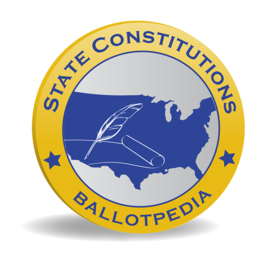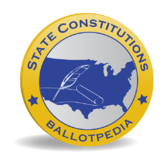Connecticut Constitution
| Connecticut Constitution |
|---|

|
| Preamble |
| Articles |
| I • II • III • IV • V • VI • VII • VIII • IX • X • XI • XII • XIII • XIV |
The Connecticut Constitution is the state constitution of Connecticut.
- The current Connecticut Constitution was adopted in 1965.
- Connecticut has had two state constitutions.
- The current state constitution has 14 articles.
- The current Connecticut Constitution has been amended 33 times.[1]
- Voters last approved a new amendment to the Connecticut Constitution on November 8, 2022, when voters approved Question 1.
A state constitution is the fundamental document that outlines a state's framework for governance, including the powers, structure, and limitations of the state government, individual and civil rights, and other matters.
Background
Connecticut became the fifth state on January 9, 1788, by ratifying the United States Constitution. Previously, the General Court adopted the Fundamental Orders on January 14, 1639, which was considered by some to be the state's first constitution, although it was adopted while the state was still an English colony. The document recognized no allegiance to England, instead it recognized an independent government. The Charter of the Colony of Connecticut (1662) officially superseded the Fundamental Orders, but the local government continued operating under the previous rules. Even after the American Revolutionary War, the state retained its same constitution for another 40 years. It was not until the passage of the first state constitution in 1818 that the colonial charter was abolished and political ties to England were officially broken.[2]
On October 1, 1901, Connecticut residents voted nearly two-to-one in favor of calling of a constitutional convention to revise the constitution. A convention was held, and a revised constitution was proposed. On June 16, 1902, residents rejected the revised constitution more than two-to-one.[2]
The second Connecticut Constitution was approved by voters on December 14, 1965, and was adopted on December 30, 1965.[2]
Preamble
The preamble to the Connecticut Constitution states:
Article I: Declaration of Rights
- See also: Article I, Connecticut Constitution
Article I contains the state's Declaration of Rights.[3]
Click here to read this article of the Connecticut Constitution.
Article II: Of the Distribution of Powers
- See also: Article II, Connecticut Constitution
Article II establishes three branches of government in the state: legislative, executive, and judicial.[3]
Click here to read this article of the Connecticut Constitution.
Article III: Of the Legislative Department
- See also: Article III, Connecticut Constitution
Article III establishes two distinct houses for the legislative branch, the sessions of the legislature and the number of members allowed for each house.[3]
Click here to read this article of the Connecticut Constitution.
Article IV: Of the Executive Department
- See also: Article IV, Connecticut Constitution
Article IV sets the terms, requirements and powers of the executive branch, such as the governor, lieutenant governor and Secretary of State.[3]
Click here to read this article of the Connecticut Constitution.
Article V: Of the Judicial Department
- See also: Article V, Connecticut Constitution
Article V establishes the supreme, superior and lesser courts as well as the process of selecting judges.[3]
Click here to read this article of the Connecticut Constitution.
Article VI: Of the Qualifications of Electors
- See also: Article VI, Connecticut Constitution
Article VI lists voter requirements.[3]
Click here to read this article of the Connecticut Constitution.
Article VII: Of Religion
- See also: Article VII, Connecticut Constitution
Article VII establishes the right to practice religion freely.[3]
Click here to read this article of the Connecticut Constitution.
Article VIII: Of Education
- See also: Article VIII, Connecticut Constitution
Article VIII establishes a free elementary and secondary school system in the state, sets up the University of Connecticut and confirms the charter of Yale College.[3]
Click here to read this article of the Connecticut Constitution.
Article IX: Of Impeachments
- See also: Article IX, Connecticut Constitution
Article IX sets up the process of impeachment and the rules for trials of treason.[3]
Click here to read this article of the Connecticut Constitution.
Article X: Of Home Rule
- See also: Article X, Connecticut Constitution
Article X allows the Connecticut General Assembly to delegate authority to cities, towns and boroughs.[3]
Click here to read this article of the Connecticut Constitution.
Article XI: General Provisions
- See also: Article XI, Connecticut Constitution
Article XI addresses the oath of office and restrictions on salary raises.[3]
Click here to read this article of the Connecticut Constitution.
Article XII: Of Amendments to the Constitution
- See also: Article XII, Connecticut Constitution
Article XII sets up how to amend the state constitution.[3]
Click here to read this article of the Connecticut Constitution.
Article XIII: Of Constitutional Conventions
- See also: Article XIII, Connecticut Constitution
Article XIII sets up the method of calling a constitutional convention.[3]
Click here to read this article of the Connecticut Constitution.
Article XIV: Of the Effective Date of This Constitution
- See also: Article XIV, Connecticut Constitution
Article XIV established that the constitution would become effective after approval by a popular vote and proclamation by the governor.[3]
Click here to read this article of the Connecticut Constitution.
Amending the constitution
- See also: Amending state constitutions
The Connecticut Constitution provides two mechanisms for amending the state's constitution—a legislative process, and a state constitutional convention. Connecticut requires a simple majority vote (50% plus 1) for voters to approve constitutional amendments. Connecticut does not feature the power of initiative for either initiated constitutional amendments or initiated state statutes.
Legislature
In Connecticut, a constitutional amendment can be referred to the ballot after one legislative session or two legislative sessions depending on the vote count.
When an amendment receives a 75% vote in both legislative chambers, the amendment goes on the ballot. That amounts to a minimum of 114 votes in the Connecticut House of Representatives and 27 votes in the Connecticut State Senate, assuming no vacancies.
When an amendment receives a simple majority vote in both legislative chambers, the amendment must pass during two successive legislative sessions to go on the ballot. That amounts to a minimum of 76 votes in the Connecticut House of Representatives and 19 votes in the Connecticut State Senate, assuming no vacancies.
Amendments do not require the governor's signature to be referred to the ballot.
Convention
According to Article XIII of the Connecticut Constitution, a question about whether to hold a state constitutional convention is to automatically appear on the state's ballot every 20 years starting in 1978. Connecticut is one of 14 states that provides for an automatic constitutional convention question.
The table below shows the last and next automatic constitutional convention question election years:
| State | Interval | Last question on the ballot | Next question on the ballot |
|---|---|---|---|
| Connecticut | 20 years | 2008 | 2028 |
The Legislature can also refer a constitutional convention question to the ballot. A two-thirds vote is required in each legislative chamber to refer a convention question to the ballot.
Proposals adopted at a state constitutional convention require voter approval.
See also
- State constitution
- Constitutional article
- Constitutional amendment
- Constitutional revision
- Constitutional convention
- Amendments
External links
Footnotes
- ↑ According to Horton (2011), the Constitution of 1965 had been amended 28 times through 1992. Since 1992, voters have approved five additional constitutional amendments.
- ↑ 2.0 2.1 2.2 Horton, Wesley (2011). The Connecticut State Constitution. New York, NY: Oxford University Press
- ↑ 3.00 3.01 3.02 3.03 3.04 3.05 3.06 3.07 3.08 3.09 3.10 3.11 3.12 3.13 3.14 Connecticut State Library, "Connecticut Constitution," accessed March 26, 2014
| ||||||||||||||||
State of Connecticut Hartford (capital) | |
|---|---|
| Elections |
What's on my ballot? | Elections in 2024 | How to vote | How to run for office | Ballot measures |
| Government |
Who represents me? | U.S. President | U.S. Congress | Federal courts | State executives | State legislature | State and local courts | Counties | Cities | School districts | Public policy |

